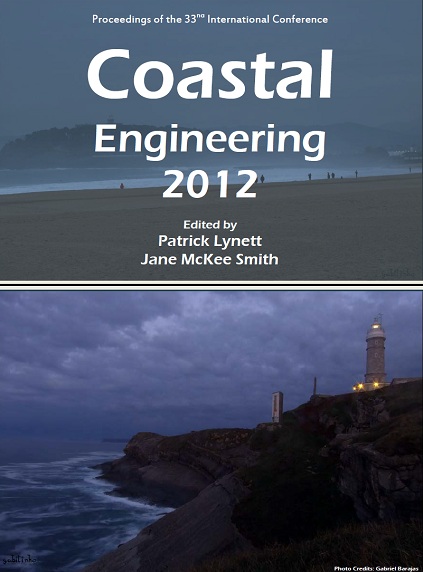Abstract
Nonuniform sediment transport exhibits difference from uniform sediment, even when the mean grain size is the same for both cases. The hiding, exposure, and armoring among different size fractions in the nonuniform bed material may significantly affect sediment transport, morphological change, bed roughness, wave dissipation, etc. It is necessary to develop multiple-sized sediment transport capacity formula to improve the accuracy and reliability of coastal analysis tools. The Wu et al. (2000) formula, which was developed for river sedimentation, is herein extended to calculate multiple-sized sediment transport under current and waves for coastal applications. This formula relates bed-load transport to the grain shear stress and suspended-load transport to the energy of the flow system. It considers the effect of bed material size composition in the hiding and exposure correction factor, which is omitted in many other existing formulas. Methods have been developed in this study to determine the bed shear stress due to waves only and combined current and waves, and in turn to compute the bed-load and suspended-load transport rates using the Wu et al. (2000) formula without changing its original formulation. The enhanced bed-load formula considers the effect of wave asymmetry on sediment transport, calculates the onshore and offshore bed-load transport rates separately and then derives the net transport rate, whereas the enhanced suspended-load formula calculates only the net transport rate due to the limit of available data. The formula has been tested using the single-sized and multiple-sized sediment transport data sets. The formula provides reliable predictions in both fractional and total transport rates. More than half of the test cases are predicted within a factor of 2 of the measured values, and more than 90% of the cases are within a factor of 5. This accuracy is generally reasonable for sediment transport under current and waves, which is very complex and little understood.References
- Bailard, J. A. 1981. An energetic total load sediment transport model for a plane sloping beach. Journal of Geophysical Research, 86(C11):10938-10954.http://dx.doi.org/10.1029/JC086iC11p10938
- Camenen, B., and M. Larson. 2007. A unified sediment transport formulation for coastal inlet applications. ERDC/CHLTR-06-7. Vicksburg, MS: US Army Engineer Research and Development Center, Coastal and Hydraulics Laboratory.
- Dibajnia, M., and A. Watanabe. 1992. Sheet flow under nonlinear waves and currents. Proc. 23 rd Coastal Engineering Conference, ASCE, 2015-2029.
- Dibajnia, M., and A. Watanabe. 1996. A transport rate formula for mixed sands. Proc. 25 rd Coastal Engineering Conference, ASCE, Orlando, USA, 3791-3804.
- Hassan, W.N.M., D.F. Kroekenstoel, and J.S. Ribberink 2001. Size-gradation effect on sand transport rates under oscillatory sheet-flows. Proc. Coast.Dynamics 2001, ASCE, Lund, Sweden:928-937. 82.
- Ribberink, J.S. 1998. Bed-load transport for steady flows and unsteady oscillatory flows. Coastal Engineering 34(1):59-http://dx.doi.org/10.1016/S0378-3839(98)00013-1
- Soulsby R.L. 1997. Dynamics of marine sands, a manual for practical applications. H.R. Wallingford, UK: Thomas Telford
PMCid:1343100
- Wu, W., S.S.Y. Wang, and Y. Jia. 2000. Nonuniform sediment transport in alluvial rivers. J. Hydr. Res., IAHR, 38(6), 427-434.http://dx.doi.org/10.1080/00221680009498296
- Van Rijn, L.C. 1984. Sediment transport, part I: bed load transport. J. Hydraulic Eng., ASCE, 110(10), 1431-1456.http://dx.doi.org/10.1061/(ASCE)0733-9429(1984)110:10(1431)
- Van Rijn, L.C. 2007. Unified view of sediment transport by currents and waves, part I, II, III and IV. J. Hydraulic Eng., ASCE, 133(6, 7): 649-689 (part I & II), 761-793 (part III and IV).

